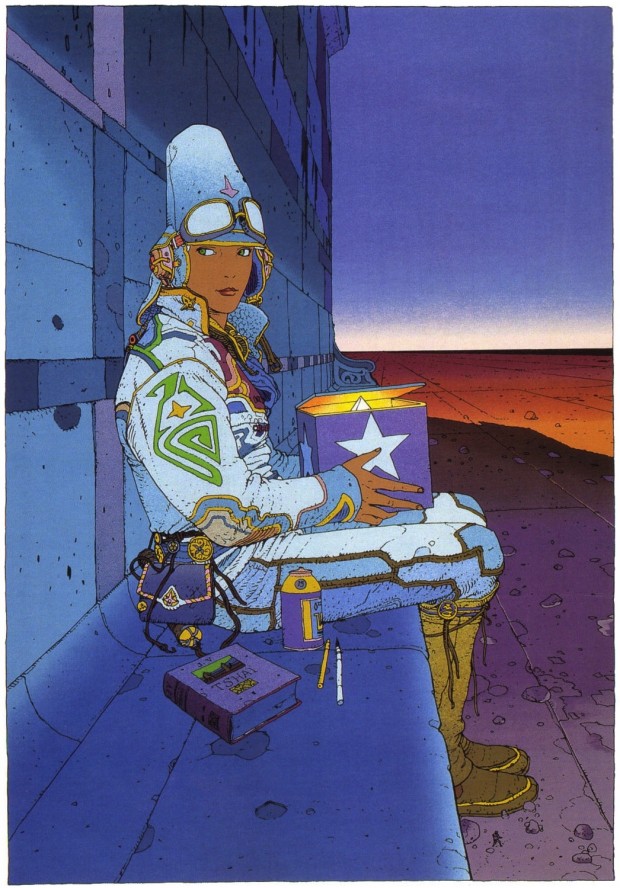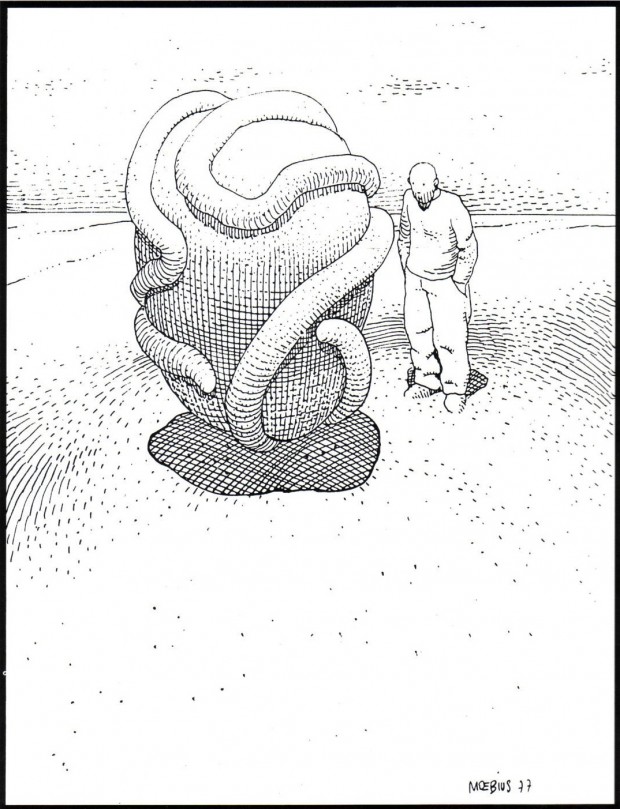An iconographic and text archive related to communication, technology and art.
☛ Inside Moebius by Jean Giraud Moebius, Tome 1, Stardom Editor, 2006, p. 4. All images from this post are copyrighted to Moebius and associated editors.
One of France’s best-known cartoonist and comic book creators, Jean Giraud, has died aged-73 in Paris after a long-illness. Giraud, also known under the names Moebius and Gir, was the creator of the hugely popular character Lieutenant Blueberry for a Western series of the same name. (RFI: “French comic book illustrator Moebius dies in Paris”, March 10, 2012)
From Le Monde:
Le monde de la bande dessinée vient de perdre l’un de ses géants, sinon “le” dernier des géants d’un certain âge d’or. Jean Giraud, plus connu sous le nom de Moebius, est mort ce samedi 10 mars à l’âge de 73 ans des suites d’une longue maladie.
Dessinateur et scénariste, père entre autres du lieutenant Bluberry, il laisse derrière lui une œuvre monumentale, marquée notamment par un trait d’une prodigieuse aisance et par une inclinaison assumée pour la dualité artistique. Ce n’est pas un hasard si Jean Giraud a mené toute sa carrière en signant avec deux pseudonymes : Gir, avec lequel il a dessiné la série western Blueberry dans une veine réaliste ; et Moebius, versant fantastique de sa personnalité, incarné à travers les personnages d’Arzach, de l’Incal ou encore du Major. La fausse désinvolture de son style a marqué plusieurs générations de dessinateurs qui voyaient en lui la référence ultime. (“Mort du dessinateur Jean Giraud, alias Moebius” March 10, 2012)
Bellow is one of numerous self-portrait Moebius drew of himself. He explains how it came to be:
[This illustration] I drew one night when I was alone in my hotel room on a trip to Europe not long ago [on October 1st, 1985]. It was around 3:00 a.m. and, because of the jet lag, I was still awake. I had been on a diet, so I had lost fifteen pounds and I was struck by my physicial appearance. It was as if somebody else was looking at me from the mirror. (The Art of Moebius, New York: Epic Comics, 1989, p. 78; originally published in Starwatcher, Paris: Aedena, 1986, p.3)

I discovered Moebius when I was a teenager. I started reading Blueberry without knowing anything about its authors. I later dived into the inebriating universe of L’Incal and discovered they were both drew by the same artist: Jean Giraud a.k.a. Moebius. I still have vivid memories of the summer days I spent slowly reading the (mis)adventures of John Difool. Recently, the complete story of L’Incal was edited as a single oversized hardcover volume with slipcase both in English and in French (2011). The first English edition (2010) is sold out but a second printing is due in May 2012.
L’Incal naturally led me to explore other mystifying albums by Moebius: Le Bandard fou (1974), Major Fatal (1979) and especially Starwatcher (1986). I remember I especially loved albums where there were no or minimal narrative: only detailed sketches, color images, no story or a simple story without any words. I still think one can stare for a very long time at a single drawing by Moebius and imagine many different stories. For that reason the Starwatcher album remain mythical in my eyes. The image bellow is famous: it’s the cover illustration for Starwatcher and it also appears on page 85 (Paris: Aedena Editors, 1986).

In The Art of Moebius, the artist explains:
This is truly a magical drawing. It is not perfect ―the legs aren’t quite right― but in this case, it doesn’t mater. The face is wonderfully evocative. I can see how someone could fall in love with a face like this. The question that is always asked when it comes to the Starwatcher series is, is the character male or female? The answer is, I don’t know. Maybe it is a man, strong and masculine, yet sensitive and soft like a woman.
A strange energy seems to emanate from the horizon. It happened quite naturally, almost by accident. When I was drawing this picture, I was trying to achieve a certain kind of feeling, so I just let myself be carried by the flow, and this was the result. I gratefully accepted it, almost like a gift. Things like this don’t always happen in art, but when it does, that’s what makes it worthwhile.
The character is sitting by a monument, waiting for a big vessel to take off. There is the book, which is by Jack Vance. The can is a can of paint. You press a button and all the colors come out. The costume is a blend of western and futuristic. Inside the box is a crystal, and it’s a present form a child who lives on this planet. And there is a message in that cube, which says, “don’t take all this too seriously!”
Moebius had his own, unique technic of drawing. The thing that stroke me the most about it was the sense a volume he was capable of injecting into each panel. Moebius’s illustrations rarely give the impression of being flat or restricted to two dimensions. On the contrary, rocks, bodies, building, vehicles all feel like they have a mass, palpable corners, round edges. The illustration below is one of those drawings that manage to produce such a feeling of volume with minimalist means. While I was in college I used this image to illustrate the cover of the notebooks for my philosophy classes. I felt it was a perfect match. It also comes from Starwatcher (on page 37):

More information about Moebius can be found online:
- Official websites: 1) Moebius.fr 2) Inside Moebius (Flash is required).
- Les Humanoïdes Associés: “Adieu Mœbius, merci Mœbius”, March 10, 2012.
- In 2007, ARTE produced a one-hour documentary titled Moebius Redux: A Life in Pictures (IMDb). I believe it was later broadcast by the BBC Four under the new title In Search of Moebius: Jean Giraud. At the moment, it’s still available for viewing on Dailymotion (in three parts, French with English subtitles). I’ve embedded the first part at the end of this post.
- Moebius was also associated with many iconic movie designs. For a quick roundup on this aspect of his life, see io9: “Legendary French artist Moebius, the man who made The Abyss, Alien, and Tron even weirder, is dead at 73” by Cyriaque Lamar, March 10, 2012.
In addition to providing preliminary designs for such films as Alien, Tron, The Abyss, Masters of the Universe, The Fifth Element, and Willow (which were awesome albeit unused), the artist provided concept art for El Topo director Alejandro Jodorowsky’s never-realized Dune adaptation, which was to star Mick Jagger and boast a soundtrack by Pink Floyd.
• • •
- By Philippe Theophanidis
- on
- ― Published in Art, Illustration, Movies
- Tagged: comic, France, Jean Giraud, Moebius, obituary, science fiction, self-portrait, Starwatcher

